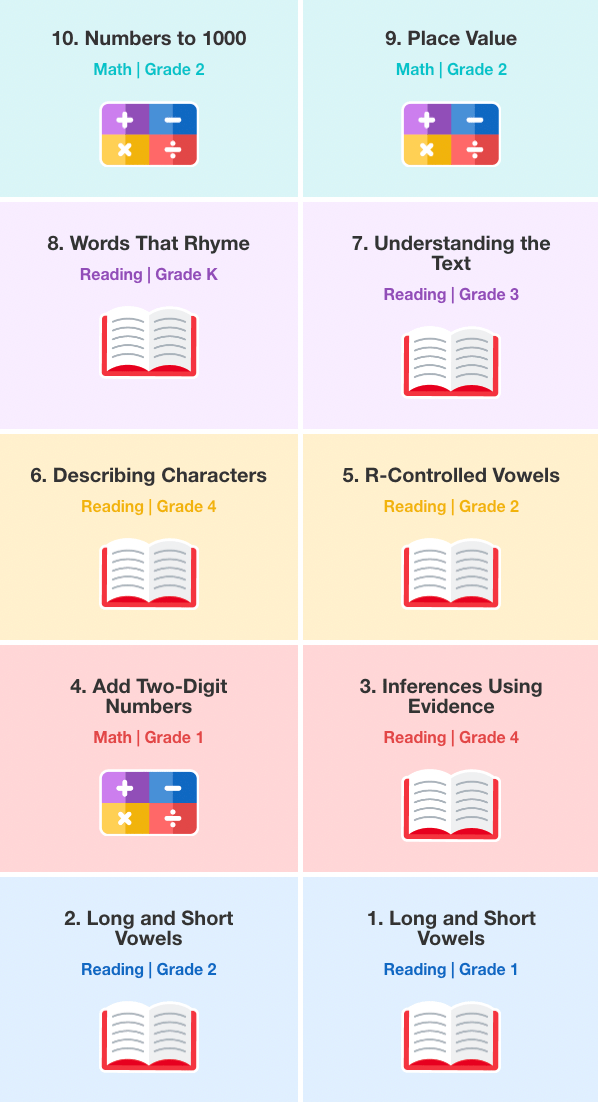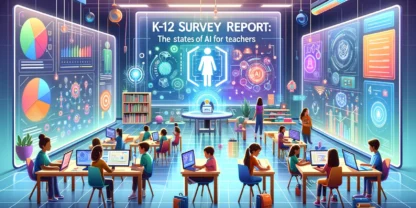Common core state standards are universal lessons that every student needs to know in dozens of states throughout the country. A second-grade student who learns how to count will eventually add, subtract, multiply, and divide those numbers. A third-grade student who learns how to understand a body of text can learn how to tell a story and convey information effectively.
However, some concepts are easier to master than others. As a teacher, you might notice that there are certain roadblocks during the school year that your students get stuck on. You aren’t alone. Our team at eSpark collected the top 10 common core standards that students struggle with in our curriculum. Learn where your students are likely to get stuck and enjoy some lesson plan ideas that make them easier to understand.

10. Numbers up to 1,000 (Math, Second Grade)
Numbers are one of the most important foundational learning concepts that students need. They make up a language of their own that is used in every level of math. Students will use numbers in science, history, and even art. As your students get more advanced, they need to understand how larger numbers are formed and the patterns that make up our number systems.
There are multiple activities that you can incorporate to teach counting – and to reinforce this concept. You can form a counting circle and bring a ball into the classroom for kids to pass around or you can drop objects into a box to help students reach different counting milestones. Most of these activities involve keeping students engaged to focus on upcoming numbers.
9. Place Value (Math, Second Grade)
Place value allows students to take collections of numbers and organize them in a way that makes sense. If you have two thousand, three hundred, and seventy-four dollars, place value tells you to write the number as $2,374 instead of $7,432. Place value is often learned alongside basic counting as students learn how to read larger numbers.
Blocks and cubes can help your students understand place value. If you enjoy bringing food into the classroom, consider teaching this concept with Rice Krispies treats. A large block can symbolize the hundreds section while individual cereal bits can symbolize ones. Other items outside of standard blocks can also be used to make this lesson more engaging.
8. Words That Rhyme (Reading, Kindergarten)
It’s sublime if you can teach words that rhyme to your kids in less time. Sadly, some learners go madly when faced with words in the same rhyming family.
You can teach rhyming words to both visual and auditory learners. To start the lesson, ask students to close their eyes. Say two words (like cat and hat) and ask if they rhyme. Say other words (like pig and sat) and ask if they rhyme. Your students will pick up on patterns to understand rhyming words. Then you can move on to visual activities. Karina Richland at the Pride Reading Program shared multiple activities to teach rhymes in your kindergarten classroom.
7. Understanding the Text (Reading, Third Grade)
As students grow more confident with words and sentences they can start to move into more advanced reading comprehension concepts. Your third graders will be able to read a paragraph and answer the basic who, where, what, why, when, and how involved.
Some learners might still think reading multiple sentences (or a whole paragraph) is intimidating. To make reading less scary, tap into visual cues. Use puppets to let students act out each sentence or bring foam visuals into the class to make the 5W and H more exciting. When text becomes hands-on, your students will be less likely to give up on it.
6. Describing Characters (Reading, Fourth Grade)
With this essential concept, you can see how common core standards build on each other from one grade to the next. While third-grade students learn to identify the “who” in a story, fourth-graders learn to describe these characters. What context clues alert readers that the Big Bad Wolf is actually big and bad? How would readers compare Grandma as a character against the Wolf, alerting Red to their differences?
To encourage students to better describe characters, tap into their young acting skills. You can play character charades where a student acts like a vampire or a lion and their peers have to use descriptive words based on their behavior. You can also place character profiles around the classroom and ask students to write descriptive words underneath each one.
5. R-Controlled Vowels (Reading, Second Grade)
R-controlled vowels describe how the letter R changes a word. For example, you pronounce the word “her” as “h-er” as opposed to sounding out “h-e-r” or making the word “he-r.”
Any lesson that incorporates the letter R is begging for the inclusion of pirates. Consider building lesson plans featuring ARRR-controlled vowels that sail the seven seas. The buried treasure and hidden pearls can be found in words that are affected by this letter. The right activities can make students stop and consider any word that has an R following a vowel.
4. Adding Two-Digit Numbers (Math, First Grade)
Addition is a key part of the common core standards for first grade. Once your students master single-digit addition (2+8) they can move on to adding multi-digit numbers (28+17). Jess Dalrymple at Lucky Little Learners shared multiple activities you can tap into for teaching this concept. These include addition color-by-number sheets, puzzles that are revealed through the right answers, and other games for your classroom.
3. Inferences Using Evidence (Reading, Fourth Grade)
Inferring information is another key part of reading comprehension. An author might not say that a character is kind, but they will include a paragraph where that character rescues a butterfly or gives a scarf to a friend who is cold.
There are multiple visual ways to teach students about inferences. However, you can also let your class act out different scenarios to let their peers infer their character. Students can pull characters from a hat and have to act them out. How does a bully act? Through observing the actions of the bully, what can students infer about their character?
2. Long and Short Vowels (Reading, Second Grade)
Long and short vowels are one of the hardest concepts to master. Short vowels make a sound (like pan or pen) while long vowels sound like the letter (like late or meet). Unfortunately, the type of vowel used in a letter isn’t always intuitive, which means your students might pronounce pan like the word pane.
There are some short activities you can use to teach these vowels. Second-grade students might need refreshers on this concept, especially if they didn’t master it the year before.
1. Long and Short Vowels (Reading, First Grade)
Long and short vowels are so complicated that they topped the list of problems that students face in both first and second grade. This is a difficult concept to learn and teach, which means you may have a hard time introducing it to students or building lesson plans around it.
As a resource, pull some of our activities for sight words. Many can be modified to teach long and short vowels – like the use of shaving cream on desks.
Overcome Mental Blocks in Common Core State Standards
All of the common core standards on this list are foundational learning elements that students need to succeed in elementary school and beyond. If a student can’t identify the “who” in a story then they can’t pick up on descriptions of the character. If a learner can’t identify numbers beyond 20, then they can’t add 25+42.
By knowing which common core standards are most likely to trip up your students, you can build additional lesson plans and activities to engage them. You can also set aside more time to learn these important ideas. You can help your students learn foundational skills that stick with them for decades.



